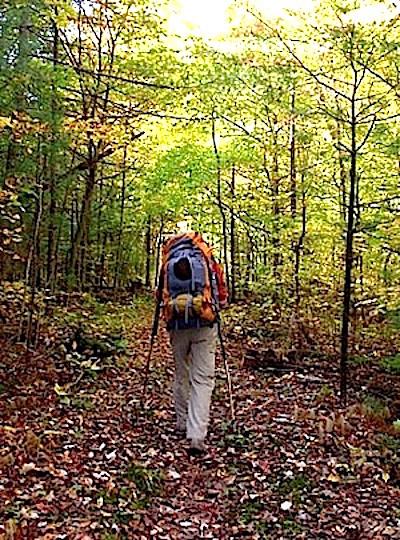
Why the declining interest in backcountry travel in the National Park System?/Bob Mishak
Glance through National Park System visitation statistics for a few years, and some puzzling numbers surface. For example: Doesn't anyone like to backpack anymore.
Ok, that was a little hyperbole. There are still a lot of backpackers in the National Park System. Just not as many as there were when Baby Boomers were coming of age.
Overall visitation to the parks in 2014 reached a record 292.8 million. But surprisingly few of those visitors spent a night -- whether in tent, on a boat, or in a lodge -- in the parks.
According to National Park Service statisticians, of those nearly 293 million who came to the parks last year, just 14.1 million stayed overnight. While that's up from the 13.5 million who spent at a night in 2013 -- that year visitation was significantly depressed by the partial government shutdown that closed most park units for 16 days -- it's slightly down from 2012 levels, when 14.3 million visitors stayed the night.
As for backcountry use, in 2014 the Park Service tallied 1.9 million overnight stays, while in 2013 there were 1.7 million, and in 2012 1.8 million. While those numbers seem bullish, they are quite a bit down from the late '70s and early '80s, when a good number of the Baby Boom generation was fit, able, and determined to see -- and sleep in -- the outdoors.
According to the Park Service, in 1979 there were almost 2.4 million backcountry travelers in the parks, or roughly 500,000 more than last year. In 1980, the number again approached 2.4 million.
Why the drop in backcountry camping, at a time when individualism is still going strong, when The North Face is seen on Broadway about as often as it is on the North Rim? That's the $64 million question.
"The NPS stats system just collects the 'how many' part of the equation - we have very little on 'why' except when there are major events, such as closings, re-openings, etc.," says Pam Ziesler, who works with the Park Service's Visitor Use Statistics Program.
Could it be related to fees charged at some national parks for backcountry access? While the small fees charged by some parks might not seem to be an impediment, access to U.S. Forest Service backcountry sites is free, says Kitty Benzar of the Western Slope No-Fee Coalition, and that might be draining some backpackers away from the parks.
Unfortunately, the Forest Service doesn't track backcountry usage like the Park Service does, and so has no easily obtained data that might indicate whether there has been an exodus of backpackers from park lands to forest lands.
Have those fees led you to vistas outside the National Park System?



Comments
More yes, but who is to say its "too much" or "too many"?
Isn't there a guideline here about ad hominum attacks?
Fads come and go.
There have been some studies of trends in the demographics of park visitors, and that would probably give even more insights to this question that trends in the general population. I recall one news story recently that described U. S. national parks visitors as largely "white and aging." If so, that's one possible factor in the declining number of current backpackers as compared to 30 years ago.
One marketing study is a bit dated (2007) but claims that "68% of backpackers are Caucasian. Backpackers skew towards a younger demographic than hikers, with 25% of all participants between the ages of 25 to 34 and an average age of 31. They are primarily male and unmarried and 31% have a household income above $75K."
I haven't chased down recent trends in the group described above, but this site says the general U. S. population age 18 to 44 is down about 6% in 2010 compared to 1980.
Some insights are probably available by delving into the following:
http://www.npca.org/assets/pdf/Committee_People_and_Parks.PDF
Jim,
I think there is a strong case for the demographics argument. I also have to agree the more recent generations have found virtual reality more attractive that real reality. I find it hard to believe that a generation that is spending $500+ for a telephone and hundreds of dollars in monthly TV and phone bills are deswaded from backpacking in the NPS because of minor gate or backcountry fees.
I tend to take a global perspective on this. Most countries now have national parks, and many of them are cherished by the citizenry in their respective countries. I don't think race plays a massive factor for people's enjoyment of National Parks, whether that's here in the states, or some place like China, Poland, or India - seems that National Parks are embraced by more than just caucasions. The economics at play is that backpacking and getting the proper equipment is not exactly cheap, even for middle class Americans.. You literally can spend 1000's on new equipment for backpacking. It's definitely cheaper than a pop-up tent, or a RV, but it's still an expensive hobby. But, most that delve deep into it, get addicted to it. I don't even want to think about all the equipment costs i've purchased over the years, as well as the costs in travel... but it's been a fairly good % of my income.
You can, but certainly don't have to.
Gary - thanks for the international perspective. I should have said the news story observed that visitors to U. S. national parks tend to be white and aging, and I made that change above. Lots has been said lately about the need to broaden the user base for U. S. national parks, and that applies to general park users, not just backpackers.